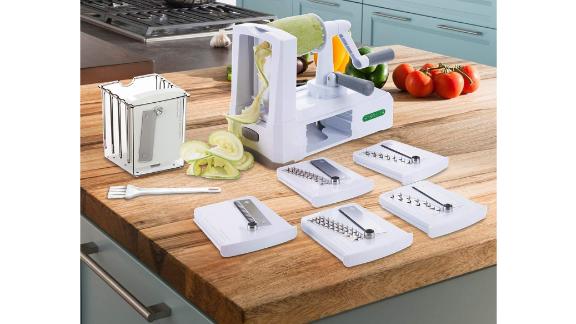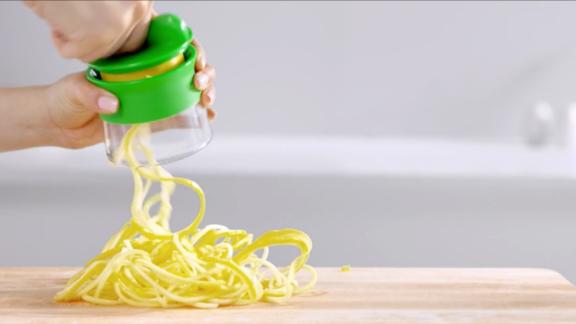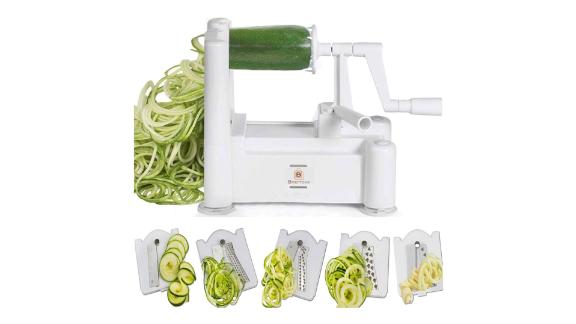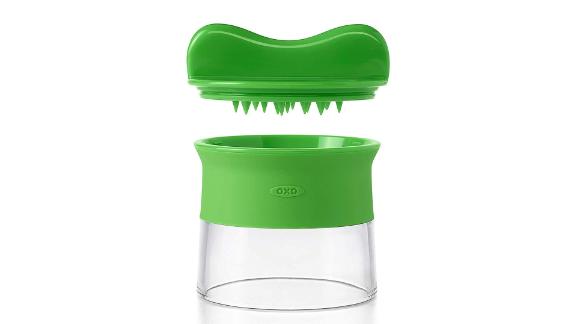Whether you’ve sworn off gluten or you’re trying the keto diet, you’re looking for a healthier alternative to pasta, you love the aesthetics of an Instagram-worthy salad or side dish or you’re just looking for ways to sneak more vegetables into your diet, spiralizers offer a quick and easy way to turn your zucchini, potatoes, carrots and other veggies into “zoodles” at home with just a few good cranks.
After weeks of testing eight top-rated spiralizers — turning 250-plus fruits and vegetables into noodles, curly fries and ribbons — we found two clear winners:
Best tabletop spiralizer: Spiralizer 7-Blade Vegetable Slicer ($24.97, regularly $27.99; amazon.com)

There’s just so much to love about this workhorse of a spiralizer. Taking its name from the genre of kitchen gadgets, the countertop model impressed us with the fact that every veggie we tested — on all seven provided blades — turned out perfect spirals, with almost all requiring barely any exertion on our part. The only veggie that gave us a bit of trouble? The pesky butternut squash, which, with its dense texture, didn’t want to play nice with the prongs, causing that end to shred as we spun the crank. (We had to slice off the end and start over a couple of times until we managed to get it going; this happened when we tested the veggie on most of the other spiralizers as well. Once we got it locked in place, though, it was good to go.)
But back to those sharp, stainless steel blades. The Spiralizer comes with seven of them — more than any other model tested: vermicelli, spaghetti, fettuccine, curly fry, chips/ribbons, fine groovy chips and coarse groovy chips. We were skeptical that there’d be much of a difference in size and shape, but each spiral we created matched its picture in the instruction manual perfectly. Now, do you really need seven blades? Probably only if you’re a veggie-loving fiend. But do they all work? For sure.
Another thing that puts these blades ahead of others: They’re clearly labeled by name, making them extremely easy to select, and the model comes with a storage box that holds four blades, while built-in storage holds another two. With one blade in the “ready” position, you don’t have to worry about accidentally slicing your finger on loose blades being stored. You also have the option of popping the blade end off to store the Spiralizer flat in your kitchen cupboard, taking up less room.
Of course, as with all spiralizers tested, the Spiralizer uses suction to keep it in place, but unlike many of the tabletop versions, this one, which features a round suction pad rather than four suction feet that you control using an on/off switch, really stayed put, not budging at all through all five veggies and all seven blades tested.
Other things we liked: The sturdiness of the noodles it created, that it’s dishwasher-safe (and was the only model tested that came with a small brush to help clear out anything stuck in the blades) and the fact that the company offers a lifetime warranty.
Best handheld spiralizer: Oxo Good Grips Handheld Spiralizer ($15.25; amazon.com)

If you want to dip your toe into the spiralizing waters, or only foresee yourself using the tool sporadically, this small but mighty handheld version is your best bet. It comes with just one stainless steel blade built into the base, but we found it cut perfectly even, long spirals, and was especially successful with zucchini.
With a sturdier build than the other handhelds we tested, the blade made extremely consistent spirals of zucchini, beets, butternut squash and potato. We didn’t have much success with carrots, which resulted in small half-moon shapes. Now, as with the other handhelds, those spirals didn’t come easy; you really have to push the pronged food holder/cap into the veggie, working those forearms to get the goods.
We did find, however, that this model is a bit easier to use when pressed down onto a cutting board. (The base has enough room to spiralize a whole small zucchini without stopping when suctioned onto a surface, and allows you to get better leverage.) We also much preferred the food holder/cap on the Oxo to other versions, with its comfortable, no-slip grip. When you’re ready to store it, it locks into the base, keeping it in one piece and the blade protected. What’s more? It’s smaller than a coffee cup, so storage is simple, both pieces can be tossed in the top rack of the dishwasher and, as with all Oxo products, it can be exchanged or refunded at any time for any reason.
A few nits: We found this handheld works better with shorter veggies. Cutting your zucchini in half, for example, makes it easier to spiralize, but also means it will take longer, as you’ll have to work in batches. And you may need to cut down wide veggies to fit the device, as they must be smaller than 2 1/2 inches in diameter.
But for the size, price and convenience? A few extra chops and minutes are well worth it.
A quick primer on spiralizers
At first glance, you may be hard-pressed to spot a visual difference between many of the models currently on the market. Generally, the tabletop versions are all made of white BPA-free plastic, are roughly the size of a breadbox and come with three or more blades preinstalled in frames that can be popped in and out to get the veggie shape you desire.
These tabletop versions make sense for those who plan to spiralize frequently or have plenty of cabinet or counter space available for storage. All the models we tested feature hand cranks attached to plastic pronglike teeth (to grip one end of your vegetable), corers that stick into the opposite end of the veggie and handles to help guide the vegetables through the blade frames.
We also tested handheld spiralizers, which include one or more fixed blades and may be better options for those who have little storage space, don’t plan to sub their flour-based pasta for the veggie variety very often or don’t mind getting in an arm workout as they prepare their next meal.
A few other notes:
- We found carrots to be tricky to spiralize because their narrow circumference makes them difficult to attach between the prong end and corer. So, when shopping, look for the widest carrots you can find — often found loose rather than bagged.
- Butternut squash makes for tasty veggie noodles but needs to be peeled first (the thicker skin takes a while and is kind of a pain), then cut up into pieces to fit on your spiralizer.
- The ribbon blade is great for cutting pretty salad veggies or thick-cut potato, beet or carrot chips.
- And, not too surprisingly, as the word “zoodles” is a combo of zucchini and noodles, zucchini simply made the best noodles on every model and blade we tested.
How we tested
After scouting the spiralizer market for top-rated, bestselling, trending and critically lauded models, we came up with a test group of eight spiralizers that ranked high in performance, build and price (though we decided to focus solely on manual models rather than the best electric spiralizers).
We then tested each spiralizer, using all provided blades to slice through five different vegetables: potatoes, beets, butternut squash, carrots and zucchini. During the testing, we also evaluated the below.
Performance
- Blade sharpness: Sharpness is perhaps the most important category when it comes to creating perfectly spiralized vegetable noodles. During our testing, we put all five veggies through the ringer, noting how well the devices handled each. When multiple blades were included, we tested every one.
- How well vegetables stay in place/rotate: Another key category, we looked at how well each food item stayed put when it was stuck between the corer and prong ends. We also reviewed how easy or difficult the handle was to rotate, including whether extra elbow grease was needed to get the vegetable to churn through the blade.
- Even cuts/how spirals hold their shape: We analyzed the spirals each model produced, looking for long, even strands. We noted whether certain veggies and blades resulted in short detached pieces or long, one-piece sections.
- Ease of cleanup: After using each spiralizer, we noted how easy it was to clean, including whether pieces were dishwasher-safe.
Build
- Ease of setup: We noted how long each spiralizer took to unbox, how many parts were included and whether blades were preinstalled.
- Suction/ergonomics: For tabletop models, we assessed how well the suction cups or pads stuck to our countertop as well as the ease of releasing that suction. For handheld models, we took note of how ergonomic each spiralizer was, including how easy it was to hold and use.
- Number of blades: We observed not only the number of blade sizes and shapes included but also the usefulness of each blade, noting whether or not each was necessary for the task of spiralizing.
- Stainless steel: As stainless steel blades are generally sharper and have longer longevity, we noted the make of each blade tested.
- Storage: We compared the size of each spiralizer, including how easy each was to dismantle and how much space it would need to be stored away in a kitchen cabinet. We also noted whether each model came with internal or external storage for blades or any other included accessories.
Warranty
- We checked the number of years of warranty on each product.
Other spiralizers we tested
Oxo Good Grips 3-Blade Tabletop Spiralizer ($39.99; amazon.com)
Our tabletop spiralizer runner-up, Oxo’s spiralizer comes with the three basic blades that will suit most spiralizing needs: 1/8-inch spaghetti, 1/4-inch fettuccine and ribbons. Stainless steel and sharp, the blades, which come housed in frames, cut through zucchini, potatoes, butternut squash and beets with ease, delivering long, continuous spirals. Carrots were trickier, and we were only able to get long spirals using the spaghetti blade. For the most part, the veggies stayed in place well while rotating. We had to readjust the butternut squash a few times but didn’t have to put the muscle into it required by other models — a sign of sharper blades and sturdier design. The suction pad on the bottom of the spiralizer clamped down well on our counter and stayed neatly in place for every veggie used, and it released easily by simply turning a lever. We were also smitten with the included blade storage box, which not only keeps the blades organized and packed away (so you don’t need to worry about any nicks or cuts when grabbing them out of the cupboard) but also cleverly fits into the blade frame slot so the spiralizer can be stored away in one piece. It also got points for being dishwasher-safe and, as with all Oxo products, the fact that it can be replaced or refunded at any time.
What kept the Oxo from winning? It was the most expensive spiralizer we tested; the blades, while color-coded, are not word-labeled; and we got better results on carrots and butternut squash from the Spiralizer.
Paderno World Cuisine 3-Blade Vegetable Slicer ($17.99; amazon.com)
At less than $20, Paderno’s take on the spiralizer is a nice option for those curious about giving this type of kitchen gadget a whirl. We found the stainless steel blades to be of average sharpness; they sliced through zucchini with total ease, while potatoes, beets and butternut squash took some pushing power, and carrots resulted in little half-moon shapes rather than the long spirals we were seeking. The four little suction cup feet took a few times to truly secure to our counter (you really have to push down on them to get them to stick), but we did like that the base of the model houses the two blade frames not in use. And about those blades: The shredder blade (for long spirals) worked best. The chipper blade (for thick spirals) resulted in frequent breaks in the spiral for most veggies we tested. And while the ribbon blade was great with zucchini, again, we just didn’t get those coveted long spirals with other veggies tested.
Farberware Spiraletti Spiral Vegetable Slicer ($14.29, regularly $29.99; amazon.com)
When it comes to slicing veggies in nice, long spirals, the Spiraletti does a fine job. Generally, the blades were plenty sharp to create the cuts we were looking for, although we had trouble with the butternut squash (the prongs continuously shredded the end of the veggie, which made it lose its grip and made rotating the handle a chore), and the carrots resulted in those half-moons when used with the two larger blades. It comes with the three most useful spiralizing blades (thin spiral, thick spiral and ribbon), which are also color-coded and labeled by name, making them easy to identify, and the base features slots for the two blades not in use, making storage easier. The four suction cup feet mostly stayed put (there was a little slipping), but the pull-release tabs took some muscle to unsuction when they were firmly in place. Farberware does offer a lifetime warranty on this model, but it was the only tabletop spiralizer we tested that was not dishwasher-safe, making cleaning it more of a pain (which can be quite literal if you nick yourself on the blades in the process).
Brieftons 5-Blade Spiralizer ($18.99; amazon.com)
While the base of the Brieftons spiralizer looks almost identical to the Spiralizer and Paderno models, it just didn’t hold up to their performance. First, it comes with five stainless blades (comparable to angel hair, spaghetti, fettuccine, pappardelle and ribbons), but none are labeled or color-coded; there’s only storage available for three of them, and one had some sort of rustlike stain on it upon unboxing (that didn’t come off when washed). Also, the blade frames were difficult to swap in and out of place. Where it was easy on all other tabletop spiralizers tested to change frames, this one took cajoling — you have to jimmy a lip in the back to get them in and out — and had us fearing we’d slice a finger.
Note: The Brieftons does come with a lifetime warranty and is dishwasher-safe. And if you’re just planning to use it for zucchini or potatoes? It held both steadily in place and produced nice spirals. But all the other veggies tested were a flop.
Adoric 3-in-1 Handheld Spiralizer Vegetable Slicer ($8.99; amazon.com)
First, we give this tiny handheld spiralizer props for a clever built-in three-blade design: You simply click buttons to switch between spaghetti, fettuccine and ribbon blades. Its small size (just store it away in a drawer) and inexpensive price (the lowest priced of all we tested) are also appealing. But when it comes to spiralizing nice and uniform long strands of noodles? We give it an OK for zucchini, a meh for potatoes and a scrunched-up nose for the rest of the vegetables we tested. The blades are stainless steel, but even the longer spirals we were able to create had to be pulled apart, as they weren’t cut all the way through. There’s no mention of the Adoric being dishwasher-safe, and we had difficulty keeping the prongs in the food holder in place on most veggies.
But our biggest nit was that it was just plain uncomfortable to use. The tri-handle design on the food holder didn’t feel ergonomic, but rather uncomfortable, making our thumb smart from the pressure it took to rotate the veggies. So, for single servings of zucchini? Sure. Anything else? You can do better.
Veggetti Spiral Vegetable Slicer ($9.99, originally $14.99; amazon.com)
You may have seen ads for this “As Seen on TV” gizmo, touting its ease at spiralizing zucchini, carrots and potatoes. During our testing, though, we found the handheld spiralizer worked well with zucchini, but not much else. The Veggetti has an interesting hourglass design, featuring dual stainless steel blades — for thick spirals on one end and thin on the other. You simply stick your vegetable into the cone-shaped opening and start twisting. Zucchinis were the only veggie we tested that held their spiral shape; others resulted in tiny to slightly bigger half-moons or, in the case of potatoes, short, cutoff spirals.
On the plus side, it’s inexpensive at $10, dishwasher-safe and super small, making it easy to store. But we found the metal handle promoted as ergonomic to be uncomfortable in our hands, and the plastic clamshell packaging was a pain to open (literally — we even cut our finger on it — ouch!). The bottom line: It’s fine for spiralizing a zucchini from time to time, but we wouldn’t use it again for anything else.
Read more from CNN Underscored’s hands-on testing:
"vegetable" - Google News
July 14, 2021 at 10:45PM
https://ift.tt/3ie2zgd
The best spiralizers of 2021 - CNN
"vegetable" - Google News
https://ift.tt/2CyIOeE
https://ift.tt/3aVzfVV
Bagikan Berita Ini
















0 Response to "The best spiralizers of 2021 - CNN"
Post a Comment